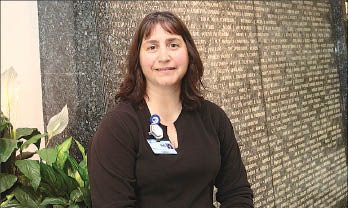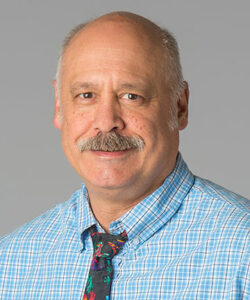
Home » Calculating hereditary factors that increase cancer risk
Calculating hereditary factors that increase cancer risk
Post Falls assessment, counseling clinic adds to range of tests it offers

June 16, 2011
People with a family history of certain types of cancer can be tested for a growing list of hereditary cancer syndromes, says the Kootenai Cancer Risk & Counseling Clinic, which is based at the Kootenai Cancer Center, in Post Falls.
The clinic recently began testing certain candidates for a gene mutation associated with increased risks of developing breast and pancreatic cancer, says Mary Sullivan, the clinic's oncology nurse. It also conducts other tests to identify people with hereditary syndromes that put them at risk to develop breast and other cancers, including ovary, colon, and skin cancers, she says.
Sullivan expects more tests to be available soon that will identify additional genetic cancer syndromes, although she says it's premature to discuss them because they need further regulatory approval.
The clinic, which is open on Tuesdays at the Kootenai Cancer Center, at 1440 E. Mullan, in Post Falls, is operated by Kootenai Health, the Coeur d'Alene-based hospital district that also operates Kootenai Medical Center, the district's main hospital.
"The main function of the clinic is to educate families," says Sullivan, who works with the clinic's medical director, Dr. Haluk Tezcan. When hereditary cancer syndromes are suspected, the clinic seeks to test multiple family members rather than just initial patients, she says.
The clinic does more counseling than testing, Sullivan says. "We explain to family members what the tests mean and what they can do with the information from them."
Candidates for risk assessment and counseling include families of people diagnosed with breast or colon cancer at a young age, ovarian cancer at any age, or who have a close relative diagnosed with cancer at a young age. Other candidates for the clinic's services include people with several close relatives who have had cancer at any age and those with relatives who have had more than one cancer at any age.
Close relatives include parents, children, grandparents, aunts, uncles, and first cousins, Sullivan says. A young age for cancer diagnosis is younger than 50 for breast cancer and colon cancer, and varies for other cancers depending on the syndrome, she says.
Patients can refer themselves for risk assessment, or they can be referred by a general practitioner or oncologist, Sullivan says.
The clinic's assessment and counseling fee is $300 and includes all counseling before and after testing.
The assessment begins with a subject completing a 17-page family-history form to help identify patterns of cancer diagnoses over a number of generations, along with data about what age family members were diagnosed with cancer. The cancer-risk assessment form helps determine whether family members should be tested for genetic mutations that increase their susceptibility to developing cancer.
"It's a big homework assignment," Sullivan says.
Costs for individual tests, which are conducted via blood or saliva samples, range from $745 for the gene mutation linked to hereditary skin cancer, to $3,200 for test for gene mutations called breast cancer gene 1 and breast cancer gene 2 (BRCA1 and BRCA2).
Sullivan says insurance policies usually cover 80 percent to 90 percent of the genetic tests, depending on individual-policy deductibles.
BRCA1 and BRCA2 are the most common inherited genetic mutations. Up to 10 percent of women diagnosed with breast cancer have the mutation. Women with either of the mutations, however, have a 56 percent to 70 percent higher chance of developing breast cancer and a significantly greater chance of developing ovarian cancer than the overall female population, Sullivan says.
Women who've inherited either of the BRCA mutations can opt for preventive surgeries including mastectomies to reduce the risk of breast cancer. Those who are done bearing children can opt to have their ovaries removed.
As an alternative to surgery, some patients might opt for medications that reduce the risk of developing breast cancer, such as tamoxifen and raloxifene, both of which block estrogen hormones that fuel the growth of breast cancer cells, Sullivan says. Oral contraceptives can significantly reduce the risk of developing ovarian cancer.
Another option is to increase surveillance through more regular self-examinations, mammograms, magnetic resonance imaging, and transvaginal ultrasound imaging.
Males also inherit the BRCA mutations and pass them to their children, she says. Males with the mutations are at greater risk of developing breast, prostate, and pancreatic cancer than the overall male population.
Males with the mutations likely would be advised to begin prostate cancer screenings at age 40 instead of in their 50s, Sullivan says.
A new test detects a mutation in a gene called PALB2. That mutation also is associated with increased risk for breast cancer and is the second leading cause of hereditary pancreatic cancer behind BRCA2, Sullivan says.
"We just this year did our first test for it," she says.
That test costs $1,400. For those who test positive for the PALB2 mutation, surveillance and intervention measures involving the pancreas would be a matter of discussion between a physician and patient based on the patient's health history, Sullivan says. The pancreas produces insulin, a hormone that helps regulate blood sugar and enzymes that help with digestion.
The clinic also tests for certain gene mutations linked to colorectal cancer. One mutation is Lynch syndrome, or hereditary nonpolyposis colorectal cancer, which the American Cancer Society estimates causes up to 5 percent of all colorectal cancer in the U.S.
People with Lynch syndrome have up to an 80 percent chance of developing colon cancer at by age 70, about 40 times the rate of the overall U.S. population, and they are much more likely to develop it earlier in life, Sullivan says.
In addition, women with Lynch syndrome also are at greater risk of developing endometrial cancer and ovarian cancer, she says.
People with Lynch syndrome should have colonoscopies every one to two years between the ages of 24 and 40, and annually after that, Sullivan says. Women with Lynch syndrome should be screened for endometrial and ovarian cancers every one to two years starting when they are 20 years old, then annually after age 40.
Another 1 percent of colon cancer cases are caused by a gene mutation called familial adenomatous polyposis, or FAP.
Of those with the gene mutation that causes FAP, up to 90 percent will develop colorectal cancer by age 70, and most will develop cancer by age 40 unless they undergo preventive surgery to remove the colon, the American Cancer Society says.
At the Post Falls clinic, genetic tests cost $2,050 for Lynch syndrome and $1,270 for FAP.
More than 150,000 new cases of colorectal cancer will be diagnosed in the U.S. this year, the American Cancer Society says.
The society also estimates that more than 68,000 new cases of melanoma were diagnosed in the U.S. in 2010, and that 10 percent of melanomas are caused by hereditary syndromes. Melanoma is the deadliest form of skin cancer, but it is highly treatable when detected early, Sullivan says.
Sullivan says patients with the melanoma gene mutation are counseled to undergo annual full-body exams and even take photos of moles to aid in spotting any changes in them. Such patients have a lower threshold for mole removals and biopsies, she says.
Demand for cancer-risk assessments at the clinic goes in annual cycles, with winter being the busiest time of the year, Sullivan says. In the first quarter of this year, the clinic had 15 referrals, and 11 were tested.
"A lot of people want to know for their own empowerment," she says. "They become more diligent about exams, and they eat healthier."
Occasionally, people counseled by the clinic don't want to know whether they have gene mutations that could lead to cancer.
"They don't want the stress of knowing ahead of time, or they don't want quit smoking or make other lifestyle changes," Sullivan says.
Unhealthy lifestyle choices, including poor diet and smoking, add to genetic cancer risks, she says.
Latest News
Related Articles





